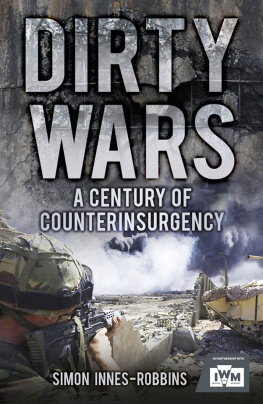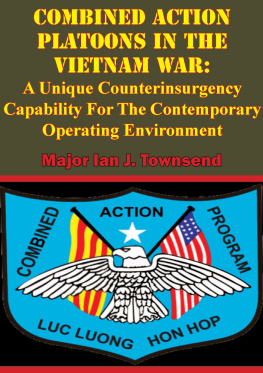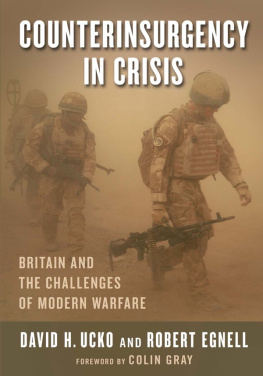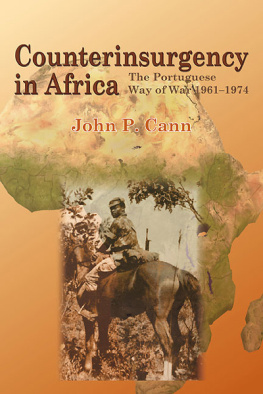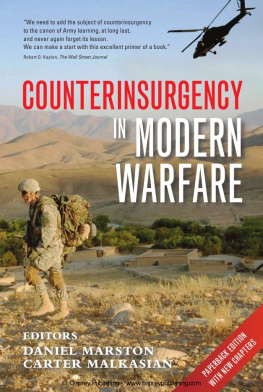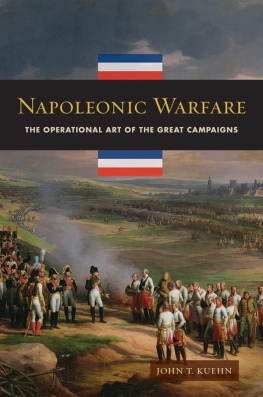DIRTY WARS
DIRTY WARS
A CENTURY OF
COUNTERINSURGENCY
SIMON INNES-ROBBINS

To Carol
First published in 2016
The History Press
The Mill, Brimscombe Port
Stroud, Gloucestershire, GL5 2QG
www.thehistorypress.co.uk
This ebook edition first published in 2016
All rights reserved
Simon Innes-Robbins, 2016
The right of Simon Innes-Robbins to be identified as the Author of this work has been asserted in accordance with the Copyright, Designs and Patents Act 1988.
This ebook is copyright material and must not be copied, reproduced, transferred, distributed, leased, licensed or publicly performed or used in any way except as specifically permitted in writing by the publishers, as allowed under the terms and conditions under which it was purchased or as strictly permitted by applicable copyright law. Any unauthorised distribution or use of this text may be a direct infringement of the authors and publishers rights, and those responsible may be liable in law accordingly.
EPUB ISBN 978 0 7524 7901 9
Original typesetting by The History Press
eBook converted by Geethik Technologies
CONTENTS
ACKNOWLEDGEMENTS
I am most grateful for and very appreciative of the forbearance and support of my colleagues past and present at the Imperial War Museum during the long gestation of this volume, notably in the Department of Research: Suzanne Bardgett, Emily Fuggle, Toby Haggith, Emily Peirson-Webber, Hilary Roberts, Roger Smither and the late Rod Suddaby; and in Publishing: Elizabeth Bower, Abigail Ratcliffe, Madeleine James and Peter Taylor.
The number of people who have contributed to my researches over many years are too numerous to name but I am thankful in particular for the extensive knowledge of Professor Matthew Hughes, Professor Peter Lieven, Professor Martin Thomas, Dr Huw Bennett, Dr Jan-Georg Deutsch, Dr Norrie MacQueen, Terry Charman, William Gee, Guy Robbins and Roger Smither, who have contributed to, read and made detailed and very useful comments on the manuscript.
Above all, I am grateful to my wife, Carol, and to my two sons, Jasper and Toby, for their fortitude, good humour and wonderful support during another long campaign.
PREFACE
THE GUERRILLA THREAT
The commitment of troops to Iraq and Afghanistan ended with ignominious withdrawal between 2011 and 2014 and saw the emergence of the cyber battlefield and of groups such as Boko Haram in Nigeria and Islamic State in Syria and Iraq. This has shown that there is a pressing need for a better understanding by the public, politicians and the military of guerrilla warfare and of the methods that can be employed to defeat it. Guerrilla warfare is arguably the future of conflict and in response armies need to function within the increased tempo and complexity of todays multi-media information age. Since involvement in Iraq and Afghanistan the American and British militaries have been looking at ways to avoid getting enmeshed in any further counterinsurgency campaigns, although these operations have generated a renaissance in doctrine and writing on counterinsurgency.
In an attempt to respond to the modern information environment, the British Army formed 77 Brigade in early 2015 as part of a major restructuring of the military organisation and development of a new doctrine of Integrated Action which would enable the United Kingdom to fight in the information age. The brigade took its name, insignia and inspiration from the Chindits, an unconventional force that fought behind Japanese lines in Burma during the Second World War. The new unit was created specifically to draw together existing and developing capabilities essential to meet the challenges of modern conflict and to learn the lessons of Iraq and Afghanistan. It would comprise soldiers who are skilled not just in the use of conventional weapons but also in soft power, notably social media, such as Facebook, Instagram and Twitter, new technology and the dark arts of psychological operations (psyops), in order to win hearts and minds through unconventional non-lethal means.
As long ago as 1971, General Sir Frank Kitson commented on an analysis of world trends showing that subversion and insurgency are current forms of warfare which the army must be ready to fight.
Sir Robert Thompson, like many others before and later, saw the war against subversion and revolutionary warfare as one of the most important struggles for domination of the world as a whole.
Guerrilla warfare is irregular or unconventional warfare in which small groups of combatants (usually civilians) frustrate and eventually defeat much larger, organised but less mobile conventional security forces (police and regular army). Usually, the guerrillas are attempting to overthrow an established government or rebelling against a foreign invader. To achieve their goals guerrillas adopt the strategy of fighting as irregulars and employing fast-moving, mobile, small-scale tactics to draw the orthodox enemy forces on to terrain unsuited to them and they employ their greater mobility and surprise to attack any vulnerable targets. As they are usually fighting against larger but less mobile conventional forces, guerrillas move quickly and keep their battles short.
The classic guerrillas tactic is hit and run, attacking only when they can do so with overwhelming superiority of numbers and quickly disbanding to hide among a sympathetic population in order to avoid being annihilated by the subsequent reaction of the security forces. By surprising their enemy and then retreating almost immediately, they prevent their foes from either defending themselves adequately or staging a counter-attack. Che Guevara emphasised that the guerrilla tactic was to hit and run, wait, lie in ambush, again hit and run, and thus repeatedly, without giving any rest to the enemy. Mao summed up guerrilla tactics:
When guerrillas engage a stronger enemy, they withdraw when he advances; harass him when he stops; strike him when he is weary; pursue him when he withdraws. In guerrilla strategy, the enemys rear, flanks, and other vulnerable spots are his vital points, and there he must be harassed, attacked, dispersed, exhausted and annihilated.
The strategy is one of avoiding the enemy when he is stronger and attacking him when he is the weaker, now scattering, now regrouping ones forces, now wearing out, now exterminating the enemy, determined to fight him everywhere, so that wherever the enemy goes he would be submerged in a sea of armed people who hit back at him, thus undermining his spirit and exhausting his forces. Typically, a small guerrilla force seeks to concentrate its strength against the weaknesses of the enemys forces, such as garrisons and outposts or lines of communication and logistics, to strike suddenly, and then to disappear into the surrounding countryside or local population. The guerrilla relies on using his greater flexibility, mobility and speed to retain the initiative and keep his more powerful enemy off-balance. Colonel C.E. (later Major General Sir Charles) Callwell noted the tactics employed by guerrillas:
They revel in stratagems and artifice. They prowl about waiting for their opportunity to pounce down upon small parties moving without due precaution. The straggler and camp follower are their natural prey. They hover on the flanks of the column, fearing to strike but ready to cut off detachments which may go astray.
While Mao emphasised that in order to mislead, decoy and confuse the enemy, there should be constant use of stratagems, such as making a feint to the east but attacking in the west, appearing now in the south and now in the north, hit-and-run attacks, and night actions.
Next page
